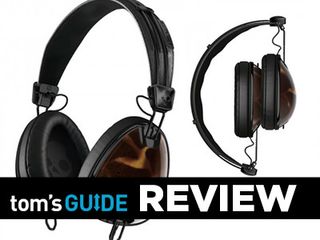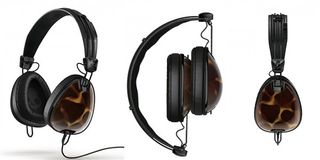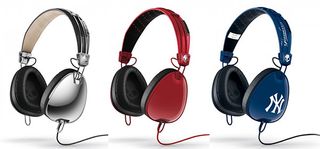Skullcandy Roc Nation Aviator Headphones Review
The Skullcandy Roc Nation Aviator headphones deliver full, rich audio in a stylish design at an affordable price.
Why you can trust Tom's Guide

Design

Skullcandy sure knows how to make a striking pair of headphones. The basic shape of the Aviators mimic the iconic shape of the popular World War II pilots' glasses. We couldn't help but marvel at the tortoise-shell pattern adorning the headphones' plastic ear plates.
Most of the plate is a lovely shade of golden brown. We love that this colored plastic has a peekaboo transparency that gives us a glimpse of the inner workings of the headphones. The top, bottom and sides of the plates are lined in silvery chrome.
The Aviators come in a variety of colors and patterns — including red, white, black and green — for $149. There's even a Yankees-themed set priced at $179.
Each ear plate has an extender running through its center. You can adjust the position of the cups by pulling them up or down. The extenders are definitely functional, but people looking for a tighter fit will have to contend with up to a half inch or more of chrome sticking out from the bottom of the headphones on either side.
MORE: The Best Headphones Available Now
An audio port for the accompanying audio cable sits at the bottom of the left can. The cans fold inward into a more compact shape for quick storage in the accompanying black leather pouch.
The ear pads are made of squishy memory foam wrapped in black leather, and the headband is made of black, synthetic leather with a plush, soft-touch underside. The top of the band has three pronounced ridges to help play up the dark-gray chrome rods held in place by a pair of slim bands. The leather and plastic rods are held at each end by a silver chrome square with a black-and-chrome skull.
In-Line Remote

The Aviators ship with a 37-inch audio cord that features an in-line remote and a built-in mic. The black-plastic remote is rather dainty but manages to hold two volume buttons and a skull-emblazoned main button for answering/ignoring or pausing/playing tracks. The remote works perfectly with the iPhone. However, when we switched to our Samsung Galaxy S4, we could only activate the play/pause feature and access S Voice. The remote didn't work at all for Windows Phone.
Comfort
The Aviators not only look good, they feel nice as well. The over-ear headphones comfortably covered our ears with supple leather as the memory foam molded itself to our head for a snug fit.
At 7.05 ounces, the cans are practically featherweight, so we could wear them for more than 2 hours without a hint of discomfort. The Soul Electronic Loops are even lighter, weighing a barely there 4.58 ounces, but they're harder on your ears.
Performance

The Aviators and their 40mm neodymium drivers delivered warm, full sound with an impressive level of accuracy. They consistently outperformed the Soul Electronic Loop headphones on just about every test track.
Our first test song, "Holy Grail" by Jay Z featuring Justin Timberlake, featured the crooner's soulful tenor accompanied by a simple piano. We heard a hint of grit in the vocals and the timbre in the chords. When bass was introduced to the track, we noticed that it was somewhat shallow in comparison to the rest of the song.
MORE: Top Gaming Mice
It was the total opposite with the Loops and their 40mm neodymium drivers. On those headphones, we heard bass so deep it lightly rattled our skull and muddied up the vocals and the other instrumentals. The piano and background vocals were also colder and flatter on the Loops.
When we switched to Pharrell's "Happy," the Aviators had the clearer-sounding percussion, particularly on the snares and cymbals. The keyboard was also full and clear, and seamlessly blended with the artist and the background vocals. However, the headphones had a light touch on the bass compared to the Loop headphones.
The Aviators lost some footing when we played John Coltrane's "Blue Train." While the track maintained a high level of audio definition, we could hear a lot of crackling and white noise. On the Aviators, the opening trumpet was somewhat hollow, whereas on the Loops, it was overly brassy.
Ultimately, we preferred the accuracy and overall fullness of audio on the Aviators to the overwhelming bass and distorted highs on the Loops.
Phone Calls
Listening to phone calls on the Aviators was a mixed bag. Our test caller reported loud, clear audio on his end. However, he could also hear the New York City traffic in the background. On our end, the caller sounded muffled and distant, but we couldn't hear any noise in the background, even though he was in a crowded restaurant.
Calling a landline got similar results: Our grandmother sounded submerged. On the plus side, she reported that we sounded nice and clear throughout the conversation.
MORE: Best Smartphones on the Market Now
Verdict

"Sophistication" isn't a word you'd normally associate with Skullcandy, but in the case of the Aviators, it's well deserved. The Aviator headphones deliver a grown-up look with premium sound at a competitive $149 price. The headphones do a bang-up job on the mids and highs, delivering rich, full audio. Our only complaint is that the bass isn't very strong and can get lost on tracks.
Fans of thumptastic lows might want to look at the $129 Soul Electronic Loop headphones. Ultimately, though, the Skullcandy Roc Nation Aviator headphones are a great choice for music lovers who place greater weight on accuracy than on head-rattling beats.
BUY Skullcandy Rock Nation Aviator Headphones >>>
| Pros | Cons |
| Mature and sophisticated design | Bass is somewhat weak |
| Loud audio with clear highs and mids | Phone calls sound muffled |
| Affordable |
Follow Sherri on Google Plus.
Sign up to get the BEST of Tom’s Guide direct to your inbox.
Upgrade your life with a daily dose of the biggest tech news, lifestyle hacks and our curated analysis. Be the first to know about cutting-edge gadgets and the hottest deals.
Sherri L. Smith has been cranking out product reviews for Laptopmag.com since 2011. In that time, she's reviewed more than her share of laptops, tablets, smartphones and everything in between. The resident gamer and audio junkie, Sherri was previously a managing editor for Black Web 2.0 and contributed to BET.Com and Popgadget.

